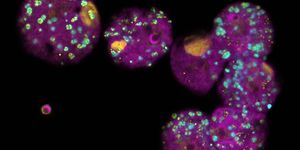Craspase - A CRISPR System That Cuts Proteins
The CRISPR/Cas9 gene editing system has revolutionized biomedical research, and has now even been used in the clinic is some rare instances. CRISPR originated in bacteria as a kind of immune defense against viruses, and different bacteria generate all kinds of Cas enzymes. Since the technology was developed, researchers have been expanding and improving it, by making it more accurate and reducing the risk of unintended edits, for example. Scientists have also repurposed CRISPR, and combined it with other enzymes such as Cas12 for different applications. Now, scientists have made a new breakthrough by identifying a CRISPR system that can target and edit one type of bacterial protein. It might one day be engineered to make other protein edits, the researchers suggested. The work has been reported in Science.
In animal and human cells, there is a family of proteins called caspases, which help control programmed cell death. This study has described a Type III-E effector complex known as gRAMP/Cas7-11, which targets RNA and is associated with a caspase-like protein called TPR-CHAT/Csx29; together, they create a tool the researchers called Craspase, which is guided by CRISPR. Craspase can cut specific RNA strands, which activates protease enzymes that break down protein.
In this study, cryo-electron microscopy was used to capture the action of the Craspase system as it functioned. The data that was captured led "to a high-definition molecular movie,” said senior study author Professor Ailong Ke of Cornell University. “By watching it back and forth, we know precisely how Craspase identifies an RNA target, how this in turn activates the protease, how long the activity persists, and what eventually shuts the protease activity off.
Bacteria use this process to thwart bacteriophages, which are viruses that infect bacterial cells; bacteria use Craspase to cut up crucial proteins, plunging the bacterial cell into a state of dormancy. When the bacterial cell is in that state, a virus infecting that cell cannot replicate, which helps reduce the risk to bacterial cells that might be nearby.
While scientists are still learning about how this process works in bacteria, it may one day be possible for us to use this system in the lab or eventually, in the clinic, just like CRISPR/Cas9.
Right now, Caspase only targets specific bacterial proteins. However, the researchers suggested that the protein could be modified so that it will target others
“We see a promising future for this new CRISPR tool with on-off switch,” said study co-author Associate Professor Stan J.J. Brouns of the Delft University of Technology.
Sources: Delft University of Technology, Science









